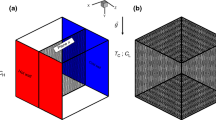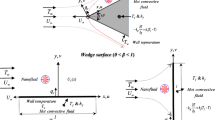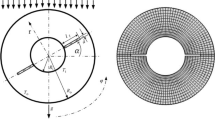Abstract
A parametric numerical investigation has been performed of three-dimensional combined thermal–solutal capillary and buoyancy convection performances of micropolar multi-walled carbon nanotubes-water nanofluid. The governing equations are given based on vorticity-vector potential formulation and numerically resolved with finite volume method. The effects of Rayleigh number (104 \(\le\) Ra \(\le\) 106), micropolar parameter (0 \(\le\) K \(\le\) 5), buoyancy ratio (− 2 \(\le\) N \(\le\) 0), Marangoni number (0 \(\le\) Ma \(\le\) 1000), and nanofluid concentration (0.0055% \(\le \varphi \le\) 0.557%) on Sherwood/averaged Nusselt number are examined along with their impact on the streamlines, isotherms, and isoconcentrations. The results imply the significant impact of surface tension on the heat/mass transfer rate, in low Rayleigh number in particular Besides, the averaged Nusselt and Sherwood numbers are improved significantly due to arise in the Marangoni number originated from unidirectional effects of surface tension and buoyancy for the thermal-dominated regime. Within solutal-buoyancy governed zone, however, an opposite trend is evidenced. Heat/mass transfer rate is overestimated when the micropolar theory is not taken into consideration. Also, the performance of multi-walled carbon nanotubes/water nanofluid depends on the nanoparticles volume concentration. Hence, there is a critical nanofluid concentration beyond which the intensity of flow increases and then declines.

















Similar content being viewed by others
Abbreviations
- C :
-
Dimensionless species concentration, \(C = \frac{{C^{\prime \prime } - C_{{\text{l}}}^{\prime } }}{{C_{{\text{H}}}^{\prime } - C_{{\text{L}}}^{\prime } }}\).
- Cʹ:
-
Species concentration (kg m−3)
- Cp:
-
Specific heat at constant pressure (kJ kg−1 K−1)
- D :
-
Species diffusivity (m2 s−1)
- g :
-
Acceleration of gravity (m s−2)
- \(\mathop{H}\limits^{\rightharpoonup}\) :
-
Dimensionless microrotation vector
- \(\vec{H}^{\prime}\) :
-
The microrotation vector (m s−1)
- K :
-
Micropolar parameter, \(K = \frac{k}{{\mu_{{\text{f}}} }}\)
- K:
-
Vortex viscosity (kg m−1 s−1)
- \(k\) :
-
Thermal conductivity (W m−1 K−1)
- L :
-
Enclosure height (m)
- Le:
-
Lewis number, \({\text{Le}} = \frac{\alpha }{D}\)
- Ma:
-
Marangoni number
- N :
-
Buoyancy ratio, \(N = \frac{{\beta_{{{\text{Cf}}}} \left( { C_{{\text{H}}} - C_{{\text{L}}} } \right)}}{{\beta_{{{\text{Tf}}}} \left( { T_{{\text{H}}} - T_{{\text{C}}} } \right)}}\)
- Nu:
-
Local Nusselt Number
- \(\overline{{{\text{Nu}}}}\) :
-
Average Nusselt Number
- Pr:
-
Prandtl number, \({\text{Pr}} = \frac{{\nu_{{\text{f}}} }}{{\alpha_{{\text{f}}} }}\),
- Ra:
-
Thermal Rayleigh number, \({\text{Ra}} = \frac{{g\beta_{{{\text{Tf}}}} \left( { T_{{\text{H}}} - T_{{\text{C}}} } \right)L^{3} }}{{\nu_{{\text{f}}} \alpha_{{\text{f}}} }}\)
- Sh:
-
Local Sherwood number
- \(\overline{{{\text{Sh}}}}\) :
-
Average Sherwood number
- t :
-
Dimensionless time, \(t = \frac{{\alpha t^{\prime } }}{{L^{2} }}\)
- T :
-
Dimensionless temperature, \(T = \frac{{T^{\prime } - T_{{\text{C}}}^{\prime } }}{{T_{{\text{H}}}^{\prime } - T_{{\text{C}}}^{\prime } }}\)
- Tʹ:
-
Temperature (K)
- \(\vec{U}\) :
-
Dimensionless velocity \(\vec{U} = \frac{{\overrightarrow {{U^{\prime } }} L}}{{\alpha_{{\text{f}}} }}\)
- \(\vec{U}^{\prime }\) :
-
Velocity (m s−1)
- x, y, z :
-
Dimensionless Cartesian coordinates, x = xʹ/L, y = yʹ/L, z = zʹ/L
- \(\alpha\) :
-
Thermal diffusivity (m2 s−1)
- β C :
-
Coefficient of compositional expansion (m3 kg−1)
- β T :
-
Coefficient of thermal expansion (K−1)
- φ :
-
Solid volume fraction
- μ :
-
Dynamic viscosity (kg m−1 s−1)
- ν :
-
Kinematic viscosity (m2s−1)
- ρ :
-
Density (kg m−3)
- \(\vec{\omega }\) :
-
Dimensionless vorticity, \(\vec{\omega } = \frac{{\overrightarrow {{\omega^{\prime } }} L}}{{\alpha_{{\text{f}}} }}\)
- \(\vec{\omega }^{^{\prime}}\) :
-
Vorticity (s−1)
- \(\vec{\psi }\) :
-
Dimensionless vector potential of velocity,\(\vec{\psi } = \frac{{\overrightarrow {{\psi^{\prime } }} }}{{\alpha_{{\text{f}}} }}\)
- \(\vec{\psi }^{^{\prime}}\) :
-
Vector potential of velocity (m2 s−1)
- C :
-
Cold
- F:
-
Fluid
- H:
-
Hot
- L:
-
Low
- max:
-
Maximum
- nf:
-
Nanofluid
- P:
-
Particle
- 1:
-
X-component
- 2:
-
Y-component
- 3:
-
Z-component
- ‘ :
-
Dimensional variables
References
Oztop HF, Kolsi L, Borjini MN, Al-Salem K. Numerical study of three-dimensional combined buoyancy and thermocapillary convection and evaluation of entropy generation. Int J Num Methods Heat Fluid Flow. 2013;24:148–68.
Arbin N, Hashim I. Double-diffusive natural convection with marangoni and cooling effects. Int Sch Sci Res Inov Phys Math Sci. 2013;7(6):1026–30.
Arbin N, Suhaimi NS, Hashim I. Simulation on double-diffusive marangoni convection with the presence of entropy generation. Ind J Sci Tech. 2016;9(31):1–5.
Alhashash A, Saleh H. Combined solutal and thermal buoyancy thermocapillary convection in a square open cavity. J App Fluid Mech. 2017;10:1113–24.
Zhang J, Sekimoto A, Okano Y, Dost S. Numerical simulation of thermal-solutal Marangoni convection in a shallow rectangular cavity with mutually perpendicular temperature and concentration gradients. Phys Fluids. 2020;32:102108.
Putra N, Roetzel W, Das SK. Natural convection of nano-fluids. Heat Mass Transf. 2002;39:775–84.
Parvin S, Nasrin R, Alim MA, Hossain NF. Double diffusive natural convection in a partially heated enclosure using nanofluid. Heat Transf Asian Res J. 2012;41:484–97.
Chen S, Yang B, Luo KH, Xiong X, Zheng C. Double diffusion natural convection in a square cavity filled with nanofluid. Int J Heat Mass Transf. 2016;95:1070–83.
Wen D, Ding Y. Effective thermal conductivity of aqueous suspensions of carbon nanotubes (carbon nanotube nanofluids). J Therm Heat Transf. 2004;18:481–5.
Jiang W, Ding G, Peng H. Measurement and model on thermal conductivities of carbon nanotube nanorefrigerants. Int J Therm Sci. 2009;48:1108–15.
Estellé P, Halelfadl S, Maré T. Thermal conductivity of CNT water based nanofluids: experimental trends and models overview. J Therm Eng. 2015;1:381–90.
Estellé P, Halelfadl S, Maré T. Lignin as dispersant for water-based carbon nanotubes nanofluids: impact on viscosity and thermal conductivity. Int Commun Heat Mass Transf. 2014;57:8–12.
Estellé P, Mahian O, Maré T, Öztop HF. Natural convection of CNT water-based nanofluids in a differentially heated square cavity. J Therm Anal Calorim. 2017;28:1765–70.
Aman S, Khan I, Ismail Z, Salleh M, Al-Mdallal QM. Heat transfer enhancement in free convection flow of CNTs Maxwell nanofluids with four different types of molecular liquids. Sci Rep. 2017;7:2445.
Mohd-Ghazali N, Estellé P, Halelfadl S, Maré T, Siong TC, Abidin U. Thermal and hydrodynamic performance of a microchannel heat sink with carbon nanotube nanofluids. J Therm Anal Calorim. 2019;138:937–45.
Garbadeen ID, Sharifpur M, Slabber JM, Meyer JP. Experimental study on natural convection of MWCNT-water nanofluids in a square enclosure. Int Commun Heat Mass Transf. 2017;88:1–8.
Kolsi L, Alrashed AAAA, Al-Salem K, Oztop HF, Borjini MN. Control of natural convection via inclined plate of CNT-water nanofluid in an open sided cubical enclosure under magnetic field. Int J Heat Mass Transf. 2017;111:1007–18.
Al-Rashed AAAA, Kolsi L, Kalidasan K, Malekshah EH, Borjini MN, Kanna PR. Second law analysis of natural convection in a CNT-Water nanofluid filled inclined 3D Cavity with incorporated Ahmed Body. Int J Mech Sci. 2017;130:399–415.
Selimefendigil F, Öztop HF. Control of natural convection in a CNT-water nanofluid filled 3D cavity by using an inner T-shaped obstacle and thermoelectric cooler. Int J Mech Sci. 2020;169:105104.
Rahimi A, Kasaeipoor A, Malekshah EH, Kolsi L. Experimental and numerical study on heat transfer performance of three-dimensional natural convection in an enclosure filled with DWCNTs-water nanofluid. Powder Technol. 2017;322:340–52.
Aminfar H, Mohammadpourfard M, Mohseni F. Numerical investigation of thermocapillary and buoyancy driven convection of nanofluids in a floating zone. Int J Mech Sci. 2012;65:147–56.
Kolsi L, Lajnef E, Aich W, Alghamdi A, Aichouni MA, Borjini MN, Aissia HB. Numerical investigation of combined buoyancy-thermocapillary convection and entropy generation in 3D cavity filled with Al2O3 nanofluid. Alex Eng J. 2016;56:71–9.
Kolsi L, Algarni S, Mohammed HA, Hassen W, Lajnef E, Aich W, Almeshaal MA. 3D Magneto-buoyancy-thermocapillary convection of CNT-water nanofluid in the presence of a magnetic field. Processes. 2020;8:258.
Sheremet MA, Pop I. Marangoni natural convection in a cubical cavity filled with a nanofluid Buongiorno’s nanofluid model. J Therm Anal Calorim. 2019;135:357–69.
Zhuang YJ, Zhu QY. Numerical study on combined buoyancy–Marangoni convection heat and mass transfer of power-law nanofluids in a cubic cavity filled with a heterogeneous porous medium. Int J Heat Fluid Flow. 2018;71:39–54.
Eringen AC. Theory of micropolar fluids. J Math Mech. 1966;16:1–18.
Ramdath G. Benard-Marangoni instability in a layer of micropolar fluid. J Non-Equilib Thermodyn. 1997;22:299–310.
Ramana MYN, Rao VV. Effect of throughflow on Marangoni convection in micropolarfluids. Acta Mech. 1999;138:211–7.
Mahmud MN, Idris R, Hashim I. Effects of magnetic field and nonlinear temperature profile on marangoni convection in micropolar fluid. Diff Equ Nonlinear Mech. 2009. https://doi.org/10.1155/2009/748794.
Abidi A, Raizah Z, Madiouli J. Magnetic field effect on the double diffusive natural convection in three-dimensional cavity filled with micropolar nanofluid. Appl Sci. 2018;8:2342–67.
Manaa N, Abidi A, Saleel CA, Al Makwash SM, Borjini MN. On simulation of double-diffusive natural convection in a micropolar nanofluid filled cubic cavity. Heat Transf Eng. 2021;42:947–65.
Manaa N, Abidi A, Ahamed SC, Madiouli J, Borjini MN. Three-dimensional numerical analysis on performance enhancement of micropolar hybrid nanofluid in comparison with simple nanofluid. Heat Transf Eng. 2021;42:1590–610.
Manaa N, Abidi A, Estellé P. Numerical simulation of three-dimensional thermo-solutal convection of micropolar multi-walled carbon nanotubes water nanofluid stabilized by lignin and sodium polycarboxylate. J Therm Anal Calorim. 2022;147:2985–3005.
Therme-Excel: Physical characteristics of water at the atmospheric pressure. Last update: 2003. http://www.thermexcel.com/english/tables/eau_atm.htm.
Guram GS, Smith C. Stagnation flows of micropolar fluids with strong and weak interactions. Comput Math Appl. 1980;6:213–33.
Sezai I, Mohamad AA. Double diffusive convection in a cubic enclosure with opposing temperature and concentration gradient. Phys Fluids. 2000;12:2210–23.
Acknowledgements
The authors extend their appreciation to the Deanship of Scientific Research at King Khalid University for funding this work through the Large Groups Project under grant number (R.G.P.2/55/43)
Author information
Authors and Affiliations
Contributions
A.A., N.M. M.D. and M.N.B. contributed to the conception and design of the study. A.A., N.M., and P.E. acquired the data. AA., N.M., and M.D. analyzed or interpreted the data. A.A., N.M., and M.D. drafted the manuscript. P.E. and M.N.B. revised the manuscript critically for important intellectual content.All authors have read and agreed to the published version of the manuscript
Corresponding author
Additional information
Publisher's Note
Springer Nature remains neutral with regard to jurisdictional claims in published maps and institutional affiliations.
Rights and permissions
About this article
Cite this article
Abidi, A., Manaa, N., Mohamed, D. et al. Three-dimensional analysis of combined thermal–solutal buoyancy and capillary convection of water-based micropolar multi-walled carbon nanotubes nanofluids. J Therm Anal Calorim 147, 12391–12408 (2022). https://doi.org/10.1007/s10973-022-11434-0
Received:
Accepted:
Published:
Issue Date:
DOI: https://doi.org/10.1007/s10973-022-11434-0




